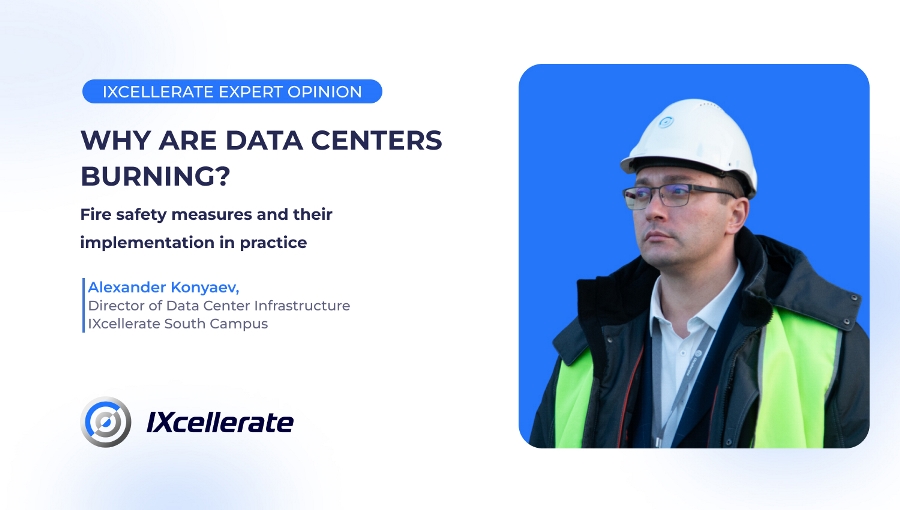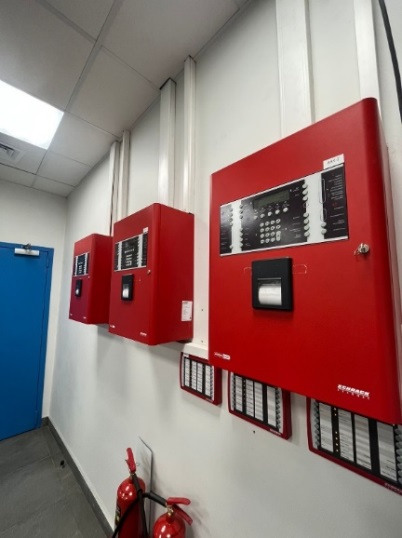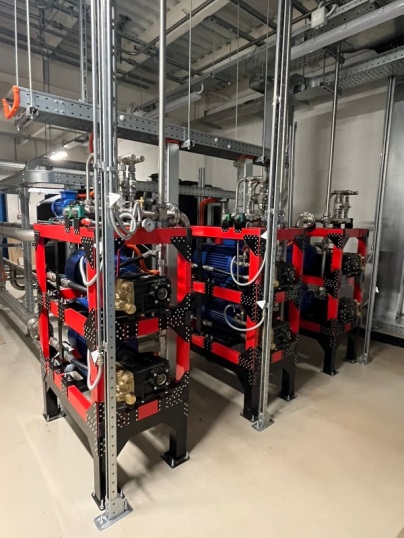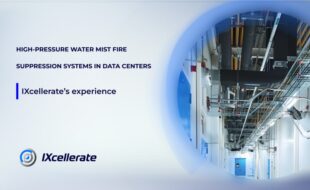
Alexander Konyaev, Director of Infrastructure at IXcellerate’s Southern campus, shares his experience and discusses the fire safety measures implemented in practice.
A data center is a facility with a high concentration of servers and engineering infrastructure, such as electrical panels, transformers, UPS, and diesel generators, which ensure smooth and fail-safe operation of the networking equipment. Based on investigative research by the Uptime Institute into DC failures, a DC fire is the most critical category in terms of gravity of consequences. On average, fires occur less than once a year.
Сauses of data center fires
Let us take a look at the most common causes of fires in the context of data centre operations:
- Failure to comply with fire safety regulations during work operations.
- Neglecting scheduled maintenance on electrical equipment.
- External factors like arson or acts of terrorism.
Analyzing data center failures helps identify the factors contributing to these incidents. Some significant factors include:
- Lack of technical maintenance documentation for electrical equipment.
- Absence of quality control over maintenance performed by contractors.
- Lack of contingency plans for equipment failure.

«During operations, the DC provider should regularly train staff on emergency response measures for all engineering infrastructure».
Alexander Konyaev, Director of Infrastructure at IXcellerate’s Southern campus
Fire scenarios
In the course of equipment and cable line operation, Data Centres (DCs) release a significant amount of indoor heat, which creates a fire hazard.
- Initial smoldering of wires or microchips, resulting in the release of small amounts of smoke into the air. Fire detection systems, such as aspiration smoke detection, can promptly detect these incidents, preventing further fire development. Electronics are often affected by gases released during smoldering and combustion, which can lead to oxidation of electronic contacts.
- Intense smoke generation within the data center rack space. Smoke sensors within the racks can alert to smoke presence, and specialized monitoring programs process the collected data.
- Detection of heavy smoke throughout the entire data center facility. This is usually achieved through addressable or non-addressable smoke detectors in the overall fire alarm system. When these detectors are triggered, fire control panels automatically activate fire suppression systems, preventing fire spread and minimizing damage.
«burned-out DCs»
While most incidents are stopped at the early stages of development, some fires may escalate beyond control.
- On 21 May 2023, a fire event disrupted the operation of the LAX12 DC of the Digital Realty company and caused a suspension of service to some customers near Los Angeles. According to available data, the firemen had to close two rooms to colocation customers.
- On 15 October 2022, a fire broke out in a data centre outside Seoul. The South Korean company Kakao said that the cause of the fire at the SK C&C Data Centre had been the lithium-ion batteries of a subsidiary of the SK Group. That brought down KakaoTalk, a messaging app that is used by some 90% of the local population. Also down were other Kakao services, including KakaoPay, mail service, taxi, etc. That was possibly the largest incident in the DC world because the fire took 32k servers offline at the same time.
- In March 2021, nearly all of an OVH data centre burned down. That has been the largest accident in recent years; after all, OVH is a major hosting provider in Europe. The fire was so fierce that it virtually destroyed the SBG2 data centre. Some 15k servers and other equipment were totally destroyed and unrecoverable.
Classification of Systems and Equipment
Ensuring fire safety in server rooms is a critical aspect for the reliable operation of information systems. The core of all fire protection systems is the fire alarm system, so it is subject to special, increased requirements for fault tolerance and maximum reliability.
One of the main requirements is the presence of an automatic fire alarm system, which should be connected to the central fire station for prompt response to possible emergencies. Additionally, it is important to have an early fire detection system integrated with other security systems in the server room. Regular checks and testing of all fire safety systems, as well as training staff on evacuation rules and actions in case of fire, also play a key role in ensuring the safety of server rooms. Furthermore, it is necessary to establish an effective passive fire protection system, including the use of fire-resistant materials and doors.
Fire protection in data centers necessarily involves activating a fire extinguishing system in case of smoke detection. The following solutions for fire suppression in data centers are commonly used:
Early fire detection system (Aspiration system).
Aspiration systems are early fire detection systems. They typically have a modular architecture that allows adapting the system to specific operating conditions and building layouts. The main components of such a system are the air intake pipeline from the controlled area and the detector itself, which can be placed anywhere inside the protected room or outside it.
When choosing aspiration systems, attention should be paid to the following parameters:
- Adjustable sensitivity;
- Patented particle filtration method.
- Dynamic sensitivity compensation depending on the dustiness of the airflow.
- Device certification;
- High-performance aspiration;
- Low noise level;
- Auto-adjustment function to the environment;
- Automatic fire alarm system.
Automatic fire alarm system.
The automatic fire alarm system is divided into the following types:
- Addressable.
- Threshold.
- Addressable polling alarm system.
This system is the most modern type of fire alarm system. It allows pinpointing the location of a fire. The receiving-control device continuously polls connected peripheral devices to analyze the dynamics of periodically recorded and transmitted values from the detectors. The receiving-control device allows monitoring the operation of each detector by states: “Normal,” “Fault,” “Fire.”

«Based on the experience, it is safe to say that an address-polling alarm system is better for purposes of DC operational excellence and fault tolerance».
Alexander Konyaev, Director of Infrastructure at IXcellerate’s Southern campus
Fire suppression systems used in data centers can also be selected based on the extinguishing agent:
- Gas-based
- Powder-based
- Aerosol-based
- HI-FOG (high-pressure fine water mist)
Categories of server rooms based on fire hazard
Requirements for server rooms regarding fire safety are determined by various factors such as the presence of electrical equipment, materials, cooling methods, and other conditions that may affect the occurrence and spread of fire. Depending on the level of fire risk, server rooms can be divided into several categories, from normal to highly hazardous:
- “Normal Fire Hazard” Category: Includes server rooms where the risk of fire is low. Standard fire safety measures are applied in these rooms, such as smoke and fire extinguisher installation, regular electrical equipment checks, etc.
- “Elevated Fire Hazard” Category: Server rooms in this category have an increased risk of fire due to the presence of more complex equipment, a greater number of electrical devices, or other factors contributing to ignition. Additional safety measures are required, such as automatic fire suppression systems or more frequent equipment checks.
- “Highly Hazardous Fire Hazard” Category: Includes server rooms with the highest risk of fire due to equipment characteristics, stored materials, or other factors. The strictest fire safety measures are required in such rooms, including specialized fire suppression systems, regular inspections, and staff training on actions in case of fire.
It is important to strictly adhere to fire safety requirements when designing and operating server rooms to minimize the likelihood of fire and ensure the safety of data and personnel. The choice of category depends on specific conditions and requires a comprehensive approach to risk assessment and taking appropriate measures to ensure the safety of server rooms.
Fire Safety in Data Centers: Recommendations
To ensure the safety of personnel and equipment in Data Centers (DCs), special attention should be paid to measures that help minimize the risks of fires.
Prepared employees can effectively respond to any emergencies related to fires if the following steps are regularly taken:
- Certification: All finishing materials, insulation, metal product compositions used in DC construction must undergo fire safety certification according to the requirements of the State Fire Supervision Service of the Ministry of Emergency Situations.
- Training: All employees, clients, and representatives of subcontracting organizations for work on campus and inside the DC must undergo training and be aware of fire safety measures. The goal of training is timely response to emerging fire-related hazards and dangerous fire factors.
- Drills: Regular practical evacuation drills for employees and clients from all buildings should be conducted, along with exercises involving the practical use of primary firefighting means for modular ignition sources. It is crucial that fire safety training begins on the first day of work and continues throughout the duration of employment.
Adhering to these recommendations will help ensure protection against fires and the safety of personnel in Data Centers.
Fire Protection in IXcellerate Data Centers
IXcellerate data centers employ high-pressure fine water mist and gas fire suppression systems. These fire suppression systems are both effective and safe for employees. Each system has its own characteristics, but all have proven themselves in practice. As part of our Colocation services, our company provides individual placement options in data center equipment rooms with the customer’s choice of an automated fire suppression system.
In specific areas of the data center infrastructure, a fire alarm system is used. This system makes decisions about fires based on various factors, employing different types of detectors installed in the same area:
- Smoke detectors
- Heat detectors
- Flame sensors



In all IXcellerate data centers, an addressable type of automatic fire alarm system is used. The central receiving and control devices consist of modular devices with full hardware redundancy of electronic components. These control panels manage fire extinguishing installations and other fire protection systems. The loops of the fire alarm system are implemented in a ring topology with the ability to connect up to 250 different devices (detectors, input-output modules, etc.). The fire alarm system controls adjacent installations of a comprehensive fire automation system (CFAS). This system provides channel redundancy in case of communication loss through a bypass path, and the interface line switching occurs at the hardware level without the intervention of an operator, thus minimizing the human factor in emergency situations.
Due to the departure of most foreign fire protection system manufacturers from the Russian market, IXcellerate actively considers and implements fire protection systems from domestic manufacturers in its data centers. For example, in collaboration with the partner “Pozhtekhnika“, we are testing analogs that have been certified and, as practice has shown, work no worse than foreign manufacturers.

«A fire is one of the most severe categories of DC failures, with serious implications. When choosing equipment for your fire safety systems, you need to impose higher requirements on safety, security and fault tolerance. As a DC operator, IXcellerate implements, wherever possible, new solutions in fire safety systems and always finds a balance in accommodating the customer».
Alexander Konyaev, Director of Infrastructure at IXcellerate’s Southern campus
Looking Ahead: Artificial Intelligence Opportunities in Data Center Industry
Modern technologies such as neural networks and artificial intelligence play a crucial role in ensuring fire safety in Data Centers (DCs). The implementation of AI-powered video cameras enables rapid and accurate detection of fire sources, surpassing traditional smoke detectors. Wireless alarm systems with wireless sensors transmit data about the surrounding environment to a central control panel, providing a reliable monitoring solution.
Innovative practices involve using AI to coordinate the evacuation of people from buildings during a fire. The neural network sends messages to people’s phones, identifies safe evacuation routes, and provides a fire development model. These technologies significantly enhance the efficiency and speed of response to fire threats, ensuring a high level of security in DCs.



